I rode my bike up to Twin Peaks on Friday, May 7, a common ride for me. But this time I went with some real anticipation and hope that I’d see a Mission Blue butterfly on the slopes. I spent an hour walking around the southeasterly slopes (on the trails mostly), occasionally sitting in a less windy spot to see if a Mission Blue would come by. I didn’t see one. But I did have a visitor who kept me company for a while:
The cacophony of song birds amidst the rushing wind and swaying wildflowers was great! But no Mission Blue for me… I was inspired to see if I could find one by an email last week from my pals at Nature in the City. It trumpeted the successful effort to restore the diminutive blue butterfly to the top of San Francisco’s iconic hills. Amber Hasselbring got a great photo of one on Twin Peaks:
An article on yesterday’s SF Gate told the story well:
The mission blue did not come back without a lot of sweat and late nights. Volunteers and scientists, under the guidance of the San Francisco Recreation and Park District and U.S. Fish and Wildlife Service, spent years on the project and expect to continue for years to come, until a stable population of a few hundred mission blues is established.
The undertaking began a few years ago, when volunteers started collecting seeds from three varieties of lupine on San Bruno Mountain. The seeds were raised in the city’s nurseries and eventually planted on the southern and eastern slopes of Twin Peaks, where they receive plenty of sun but are sheltered from the wind. Volunteers and city gardeners regularly hiked up the steep hillsides, toting buckets, to water the lupines and remove nonnative grass so the lupine had room to grow.
Last spring, when the lupines finally appeared well established, the city was granted a permit from Fish and Wildlife to capture 22 pregnant mission blues from San Bruno Mountain and relocate them to Twin Peaks. Once the butterflies were trucked across town, each was carefully placed on a lupine plant and covered with a net. Volunteers sat up with the butterflies throughout the first few nights to monitor their condition and see if the butterflies were laying eggs.
Mission blues live for only a week or so as adults, so after a few days the nets came off. But volunteers continued to visit the sites throughout the year to see if the eggs were hatching and transforming into larvae and caterpillars. Then, on Thursday morning, almost exactly a year after the pregnant females were relocated, O’Brian was tromping around the hillside with a butterfly net and suddenly shouted, “I see one!” A crowd of volunteers, scientists, officials and journalists sprinted across the grass in hopes of glimpsing the prized, 1-inch bug. After watching the fluttering blue insect skip across the grass, the awestruck crowd dissolved into smiles and congratulatory pats on the back.
Amber and some other local activists are also involved in restoring a corridor for the Green Hairstreak, a very San Franciscan-looking green butterfly that likes the ridge east of and overlooking the Sunset district.
I think a lot of folks around here are excited to imagine that such restoration efforts can show results. Granted, it’s a tiny piece of a daunting puzzle, but I like this as an example of participating in an urban effort to harmonize with natural processes. It is as restorative to our sense of connecting to our surroundings as it is to the habitat of the Mission Blue.
I went to see Judy Rebick, a well-known Canadian writer and feminist activist, talk about her book “Transforming Power” the other night. She’s a lively thinker and spoke with enthusiasm about her encounter with the popular movements in Bolivia back in 2006. I have a number of friends who just went to the Water/Climate Conference in Cochabamba, Bolivia, so I’ve been hearing a lot of excitement and energy coming from that direction. She reported on their recent embrace of a call for a “A Good Life” for all, defined by saying “there’s enough of everything for everyone, but there’s not enough for some people to have more than others.” I liked the lyrical simplicity of that description. It feels very parallel to what I’ve made my own quixotic mission, to make what we do and how we do it key questions to be faced politically. The point, supposedly, of the economy, is not its self-perpetuation but actually to achieve human well-being. We now know we have to add in ecological well-being in an integrated whole that includes all forms of life. But the economy–that is to say, our work as channeled by “jobs” we are paid to do–is antithetical to human and ecological well-being.
But as the butterfly efforts show, it takes a LOT of work to get our lives moving towards a more cooperative and responsible relationship with natural systems. So to provide everyone with a good life will take a lot of work, and a lot of careful calibrating with Mother Nature…
Which brings me back to Utopia, because some of you must certainly be raising your eyebrows again, figuring ‘here comes more wild-eyed, impractical exhortations’ or something like that! Last time I spoke about some local utopian efforts in the 19th century, and then went on to disparage a couple of shows at the SF Int’l Film Festival. I was a bit harsh on my friend Sam Green, and I want to publicly apologize for it. We had a nice lunch and discussed our varying views on utopia, art, history, etc., and I give him all the credit for reaching out to do that. While agreeing to disagree on his show, we found a lot of common ground on our sense of Utopia as a realm of inspiration and imagination. He also took offense at the term ‘slacker’ which I used to characterize a certain aesthetic and cognitive sensibility. (I took part in an online discussion of slackerdom a year ago or so, and didn’t see it as necessarily so perjorative.)
Anyway, my film festival continued with more films that obliquely touched on the theme of utopia. Life 2.0 is a documentary about a small number of people who spend an large part of their lives in Second Life. A couple falls in love and tries to get together in real life, a businesswoman sees her business soar and crash, and a child-abuse survivor (who figures it out by being an 11-year-old girl in Second Life). My take on it, as seen through these particular experiences anyway, is that people who can’t find what they want in their real lives can sometimes transcend their limitations in Second Life. It’s quite addictive, like video gaming, for those who get into it. The businesswoman is a rather obese black woman living in the basement of her parents’ home in Detroit, getting up at 6 pm every day to sit in her pajamas designing Second Life fashions and interior decorations all night while smoking cigarettes. At some point she’s a big hit and actually claims to have made in “six figures” for a year. But her clothing and shoe styles, etc. (easily duplicable groups of pixels after all) are stolen, reproduced and made available for free elsewhere in Second Life, driving her to reconsider the real world as a place to find employment.
I guess you have to concede that Second Life represents some kind of experiment in utopia, since everyone there is free to do what they want, to create digital environments to match their fondest fantasies. They can behave any way they’d like through their “avatar” and can assume the outward appearance of any race, gender, age, or class. But it really seems like a place where sad sacks go to experience vicariously the life they’ve been unable to find around them in their real lives. One of the film’s subjects was there for the Q&A (the child abuse guy whose fiance leaves him over his obsession with being an 11-year-old girl in Second Life) and he says that now it’s just another place he spends time in his life. It sounded like a park, or a local cafe, or any other kind of environment different than home or work. But he, like many in SL, is doing work there too… many millions of dollars change hands in Second Life every year, real dollars! Hard to believe…
The film “Queen of Karo” was a well-done story of an anarchist squatter commune in 1974 in Amsterdam, but seen through the eyes of the 11-year-old daughter of a Belgian couple. They go to Amsterdam because they’ve heard they can live there for free, a group of a half dozen adults, including the couple. The prostitute who lives downstairs and helps the new commune get electricity tells the landlord when he comes around that “they’re still trying to make utopia up there.”
The guy (father) is a charismatic, good-looking 30-ish man, and his wife (mother) is very beautiful. While he’s foraging and stealing to support the group without money, wage-labor, or rent to pay, she starts sewing, and eventually makes money by sewing costumes for a local opera troupe (other commune members are actors in it too). But the dad is pissed that any kind of commerce is going on. The daughter is confused. She has a pet hedgehog, but at some point she freezes it in a small plastic tub of water, assuring it that she’ll “wake it up” when “things are better.” She wakes up to the groans and moans of group sex, and later, watches as her father begins a new sexual relationship in front of her mother, who eventually is drawn into it in the sexually liberated mid-1970s. The landlord turns off the water, the mom secretly starts paying the landlord, but eventually it all blows up. The squat is busted, everyone evicted, and both the commune and the small family are torn apart. On a nearby bridge over a canal, the mother and father and daughter meet after dad is let out of jail (after rioting against the eviction). Father asks mother what she’s going to do, but she can’t answer. The daughter takes over and announces that mom is getting a place on her own. Both parents ask her what she is going to do. She says she’ll live with her mom… and then that she’ll visit her dad when she feels like it. It’s a mature denouement to a story of that era’s boundarylessness, a structure figured out and announced by the child who had been largely denied the structure and boundaries even she figured out she needed. Very good movie!
“Last Train Home” is a look at the annual migration of 130 million Chinese migrant workers, who go home each year for Chinese New Year. Incredible camerawork, cinema verite look at a family split by migrant parents leaving children behind with grandparents 16 years earlier. Highly recommended! Nothing utopian about this view of Chinese garment factory workers, still hanging on to a steadily unraveling relationship to their rural roots.
Well… being a blog, I don’t really have to be completely coherent and tidy here… I’ll end with a few shots of what I saw on Twin Peaks today… can anyone identify this bird? I looked in my Western Birds guidebook and couldn’t find it…
One of my favorite things about hiking in local hills, especially after such a rainy winter, is the profusion of wildflowers. I posted some a bit ago, but here’s the tiny ones you can’t see unless you look closely at the ground. I left my foot in so you have something to gauge the size with (I do have a big foot!)…

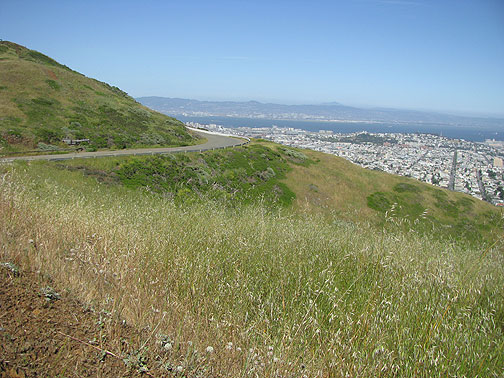
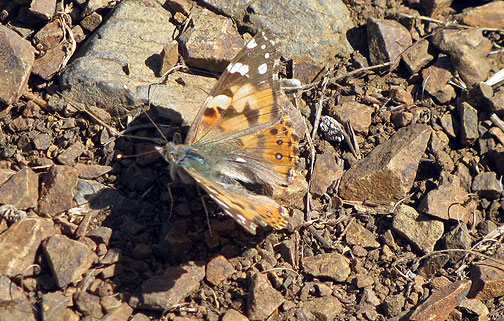
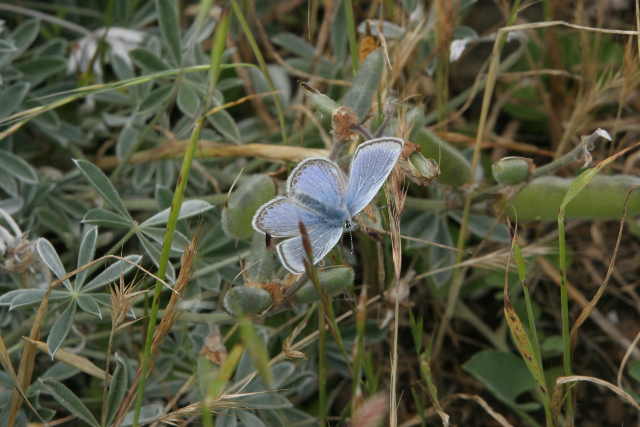
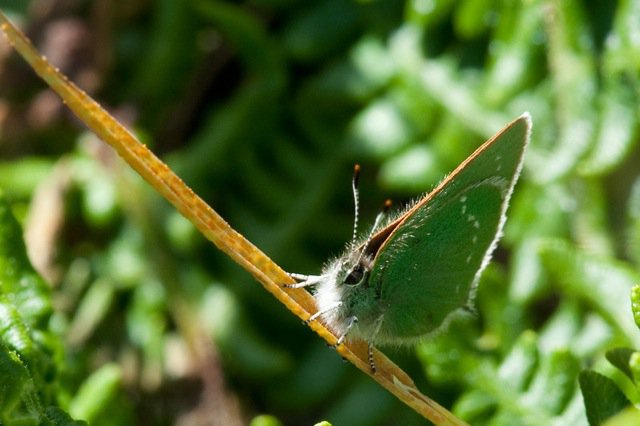

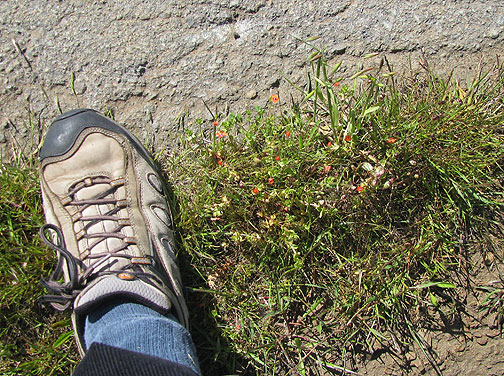
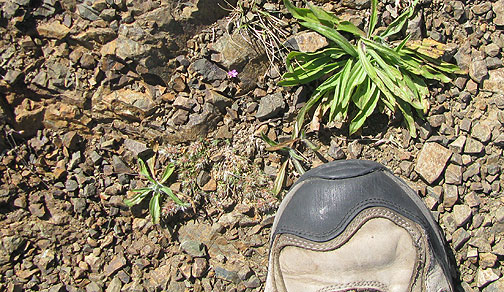
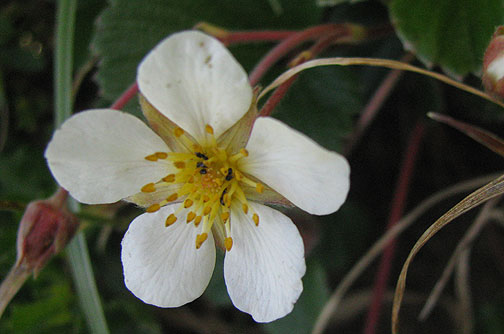
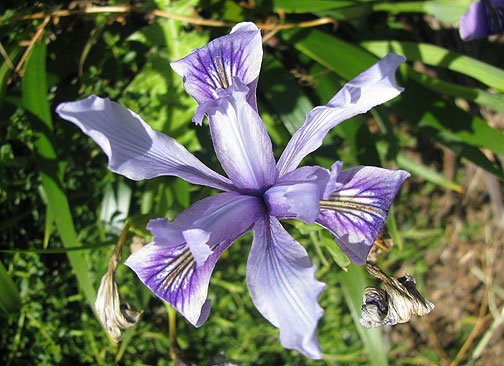












Hi Chris. Nice pictures and interesting story. I am pretty sure that the red breasted bird is a male House Finch – native to the North American West, and adaptable to life around humans.
Chris, the pale salmon colored flower is a member of the pimpernel family- I thought. That’s what Alexis always told me. I loved the picture of the green hairstreak! Amazing.